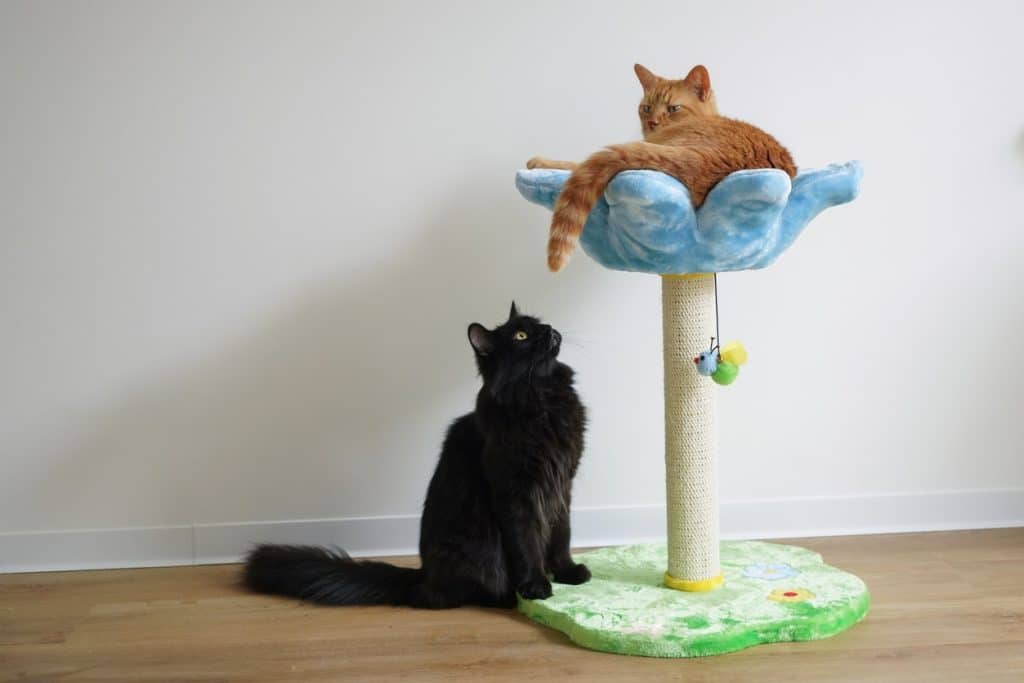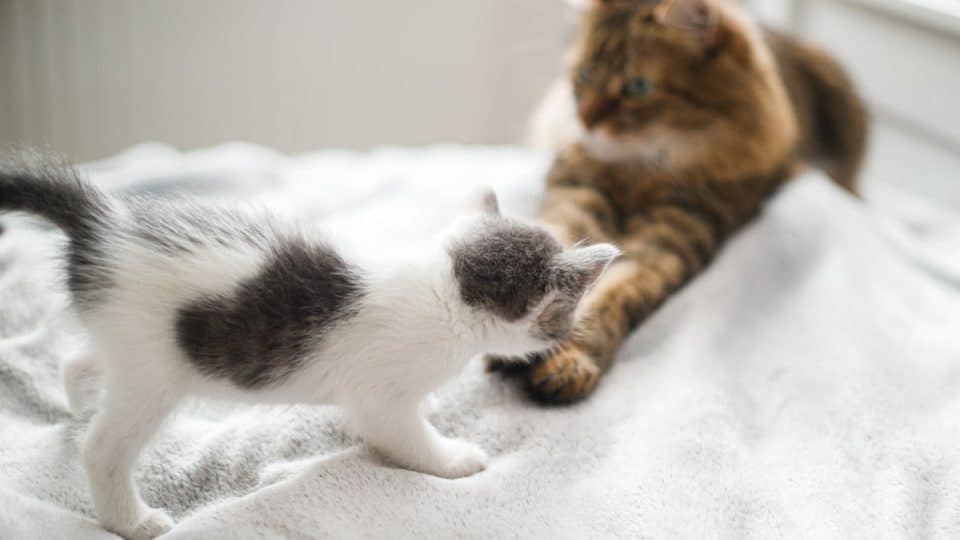- Not a substitute for professional veterinary help.
As pet parents, we have big dreams of our cats getting along like best friends—but introductions are hard, and an older cat and a new kitten can sometimes get off on the wrong paw.
“Despite videos you see on social media of cats instantly getting along, rarely do you see older cats tolerate kittens within the first few weeks of them being there,” says Joey Lusvardi, certified cat behavior consultant and founder of Class Act Cats. “Often times it takes months. In some cases, it may be over a year.”
The good news, however, is that it’s often possible to repair relations. Here’s what to do if you’re worried your old cat hates your new one—or vice versa.
How To Help an Older Cat Get Along With a New Kitten
Ideally, introductions between a new kitten and older cat are made up of several slow and controlled stages. Swapping scents, separate rooms, and a gradual (and often gated) face-to-face meet and greet are hallmarks of safe and effective cat introductions.
Sometimes, though, even if you do all the right things, it doesn’t stick the first time. Here’s what to do next.
1. Separate and reintroduce the cats
Lusvardi says a separation and reintroduction is the most effective first step. “You need to go much slower the second time, because now not only are you trying to get the cats to like each other, but you need to undo the damage that has been done,” Lusvardi advises.
Carefully monitor your new kitten’s and older cat’s body language and vocalizations at every interaction. It’s important to cut off the interactions before anyone hisses, growls, or jumps on the other.
2. Separate food stations
Some people recommend feeding new cats next to each other to help them bond, but Lusvardi recommends against it. “Cats are not social eaters. It’s actually aversive for them to eat near other cats.”
The positive associations of food aren’t likely to transfer to the other cat—so you’re better off separating your kitties during meal times.

iStock/uzhursky
3. Try positive reinforcement with clicker training
Clicker training is a positive reinforcement technique that’s seen significantly more success than mutual feeding in patching up problematic cat relationships.
You’ll start by teaching each cat to expect a good cat treat when they hear the sound of the clicker. Then you’ll begin rewarding them with the clicker when they engage neutrally or positively with each other. A certified cat behaviorist can help you learn to clicker train a cat.
4. Interrupt any fighting quickly and positively
If cat-on-kitten fighting breaks out, it’s important to interrupt it in a safe and effective way.
Don’t use spray bottles or fear-and-startle methods, since these tactics can actually increase arousal and make fighting worse. It’s also not a good idea to stick your hands into a cat fight.
Instead, de-escalate a cat fight with distraction and redirection. That might mean tossing a favorite toy across the room for your cat to chase, or separating the cats with a barrier.
“I’m a big fan of taking a large flattened cardboard box and sticking it between the cats. This stops them from seeing each other, which will decrease some of the tension, protect them from each other, and allow you to safely guide one of them to another room,” Lusvardi says.
5. Make sure there are enough resources
A lack of essential resources can contribute to discord between cats. Dr. Rachel Geller, a certified cat behaviorist and founder of All Cats All the Time, Inc., suggests creating multiple food “stations” to reduce feelings of vulnerability and competitiveness.
Litter boxes are also a territorial hot spot, since it’s easy for a cat to block access to a single litter box or spring an attack on the other cat. Geller recommends having at least one litter box per cat, plus one extra.
“Make sure the litter boxes are uncovered,” she adds. Your cat needs to see what’s going on around them.

iStock/Olga Drach
6. Provide several safe spaces and retreats
The more secure your older cat feels in their surroundings, the less threatened they’ll feel by the new kitten. Provide various cat furniture options, including ones your kitten can’t access.
“A safe retreat can make a big difference to a cat,” Geller explains. “Your cat needs private time, and cat trees, high shelving, and hiding spaces are perfect ways to provide this.”
Just make sure that any enclosed resting areas have multiple exit and entry points.
7. Increase play and enrichment
Cats thrive with daily play, and enrichment plays a massive role in preventing fighting and aggressive behavior. When cats are bored, they can become stressed and anxious. They can take their negative feelings out on each other.
Geller recommends wand toys, fishing pole toys, and feeder puzzles, followed by a treat or meal and then a nap.
Lusvardi agrees, adding that play sessions need to happen before any fighting starts—not after.
8. Work with a cat behaviorist
Trying to fix a cat introduction gone wrong doesn’t have to be a solo endeavor. A professional cat behaviorist can offer another perspective and new solutions tailored to your specific kitties.
“For most of us, repairing cat relationships is the biggest reason we’re consulted. My top behavior problem I help clients with is a kitten not getting along with a senior cat,” Lusvardi says.
Signs Your Cat Is Accepting the New Kitten
There isn’t a one-size-fits-all timeline for an older cat to accept a new kitten. Every situation, like every cat and kitten, is different. There are, however, positive signs to look out for that can indicate you’re on the right track.
You should see less growling, less hissing, and fewer behavioral signs of stress like excessive grooming, destructive scratching, or litter box problems.
“The biggest sign to look for is a lack of signs of anything. Their interactions should be really boring,” Lusvardi says. “Tolerance and ignoring is good!”
In other words, the new kitten and older cat should be able to walk by each other without a strong reaction, there shouldn’t be staring, and the kitten should leave the older cat alone when the older cat is resting.
Signs It’s Not Working
On the other paw, there are ample red flags that your attempts to get your older cat and new kitten to tolerate each other isn’t working.
Look out for these critical behaviors:
- Spraying
- Litter box avoidance or inappropriate elimination
- Refusal to eat
- Hiding for hours
- Jumpiness and skittishness
- Excessive grooming
- Lethargy
- Physical injuries on the cats
- Redirected aggression to humans
When To Give Up on Cats Getting Along
When there’s no chance of a feline peace, it’s time to consider rehoming.
Our experts emphasize that “rehoming” isn’t a dirty word. It doesn’t mean you’re selfish. It doesn’t mean that you don’t care about your cats. It doesn’t mean you failed your older cat or your new kitten.
“In some cases, it’s actually the kindest thing to do,” Lusvardi says. “If a kitten isn’t going to be allowed to thrive in their environment or a resident cat is going to be really unhappy with the other kitten there, you are doing the responsible thing by helping the kitten get to a better home.”
While there’s no set-in-stone timeline for when to give up on an older cat and new kitten getting along, Lusvardi says it’s important to:
- Be honest with yourself. Do you have the time, patience, and energy to slowly work on your cat and kitten’s strained relationship for the next few months to a year? If the answer is no, begin to think about rehoming now before you become attached to your new kitten.
- Be aware of serious behavioral issues and signs of struggle and suffering. If a vet rules out any medical problems or health conditions and you notice the red flags above, taking swift action through rehoming can protect your cats (and you) from further emotional distress and possibly even physical injury.
How do I rehome my kitten?
“Rehoming yourself is hard to do correctly, so in most cases, you’re better off getting connected with a reputable rescue or shelter,” Lusvardi says. “Shelters and rescues have a lot more resources and experience getting cats into homes.”
When choosing a shelter, Lusvardi says it’s key to visit the building in person, meet the staff, and ask a lot of questions. It’s also important to do your research and see what sort of reputation the shelter has.
Alternatively, you can choose a foster organization instead. Just be aware that even if foster homes are less stressful, shelter kittens are seen more frequently and actually get adopted more quickly.
If you decide to rehome the kitten on your own, Lusvardi says to be thoughtful and cautious. Thoroughly look into who the potential adopter is, check their references, and honestly consider if they’re going to be a good fit.
Charging a rehoming fee is an option, but Lusvardi says to be aware that it could cause barriers for a potentially great adopter. If someone is truly a great fit but can’t afford the cost of the kitten, consider reducing it or waiving it entirely.
Lastly, whether you rehome your kitten on your own or through an animal shelter or foster organization, Lusvardi says it’s essential to be honest about the kitten’s history.
If the kitten didn’t like the older cat, tell potential adopters that the kitten may be better off in another home without another cat.
If the older cat didn’t like the kitten, tell potential adopters that the kitten might do well with kittens who are around the same age with a similar play style.



